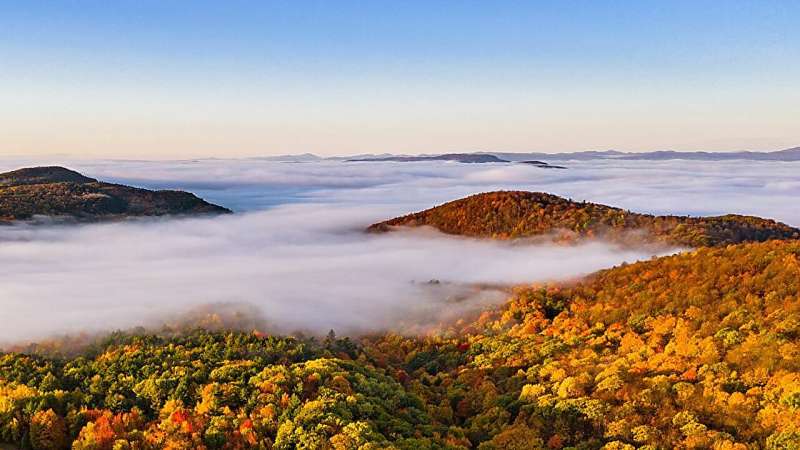This article has been reviewed according to Science X's editorial process and policies. Editors have highlighted the following attributes while ensuring the content's credibility:
fact-checked
trusted source
proofread
Q&A: How extreme weather impacts fall foliage

After a summer of extreme weather—historic rainfall, devastating floods, wildfire smoke—leaf peeping season has finally arrived in Vermont and New England.
With trees set to reveal their brilliant fall colors, UVM experts weigh in on how this summer's extreme weather will affect fall foliage, which generates more than 1 billion dollars for the U.S. economy—and $800 million in Vermont alone.
What do you expect for fall foliage 2023?
"Fall foliage in Vermont and New England always delights—and will again this year. There's always a little mystery because the color and timing of the leaves result from a delicate dance of many different factors—some environmental, some in the tree—before a great reveal. That's what makes it so exciting and special for so many people.
"Each year, there are subtle differences in the timing and brilliance of fall foliage that result from the weather and temperatures over the past two years. This year trees have been stressed physiologically by two types of extreme weather we've seen in the Northeast: A summer of historic rainfall versus two previous years of drought.
"Like drought, heavy moisture can cause leaves to drop off sooner than usual and have more muted fall colors overall, while the warming fall temperatures are delaying the onset of fall colors, resulting in a shorter foliage season," says UVM Prof. Bill Keeton.
How will our extreme rainfall affect fall foliage?
"One effect of our extremely wet summer is we're seeing some leaves dropping off trees early. The Northeast is not adapted for rainforest-like conditions—so too much moisture produces fungal diseases on leaves, including anthracnose, which causes leaves to turn yellow with brown spots, and curl up and drop early.
"So we may see fewer leaves become deep red and purple color in some places, because they're falling before the trees have the chance to produce the chemical that causes the leaves to make those colors. The moisture is causing fungal diseases on the leaves of many food crops, too, such as pumpkins and tomatoes," says UVM Extension Assistant Prof. Alexandra Kosiba.
What about the wildfire smoke from Canada?
"Extended cloudy periods can affect fall foliage, so the hazy conditions in Vermont and the Northeast from wildfire smoke could potentially have a similar effect. Leaves are designed to catch sunlight primarily from the top, but cloudy skies can reduce the amount of sunlight they get and deflect the rays in other directions.
"That can slow photosynthesis in the leaves and produce less vibrant colors—especially the reds—and a shorter foliage season. I think we're seeing some of these effects in a lot of other green plants this year," says UVM Extension Assistant Prof. Alexandra Kosiba.
"With mega-fires increasing year by year, in the Western U.S. and now Canada, this is an issue to watch. We don't have conclusive evidence yet, but some studies suggest that ash and smoke particulate deposits on tree leaves may hinder photosynthesis somewhat. Thankfully, we have yet to find ash deposits on Vermont leaves, possibly because of all the rain since the fires," says UVM Prof. Bill Keeton.
Any economic and social trends for 2023?
"Vermont's tourism was hit hard by this summer's devastating flooding—and before that COVID, and growers experienced a destructive hard frost. So businesses are hoping for a big fall to regain lost revenues. The big marketing message is that Vermont is open and ready to create the authentic experiences that keep people coming back here—from connections with nature and agriculture to famous farm-to-table food and drink.
"In the face of natural hazards and climate change, the Vermont agriculture and tourism sectors keep innovating. This year, for example, maple sugar houses are opening early to host foliage viewing experiences through the Maple 100 initiative.
"Another trend worth watching are media reports of fall road closures in Vermont communities and businesses, which leaf peepers have made Instagram-famous and crowded, are temporarily closing this year for sustainability reasons. So people should check Vermont's tourism website—or talk to a Vermonter—to find good places to enjoy nature's show—and act sustainably," says UVM Extension Prof. Lisa Chase.
Provided by University of Vermont





















